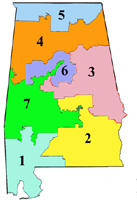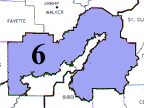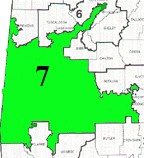Alabama Redistricting 2000
|
| | 
| Alabama’s Political Lineup | | 1991 | 2001 | | Governor | R | D | | State Senate | 28D, 7R | 24D, 11R | | State House | 82D, 23R | 68D, 37R | | US Senators | 2D | 2R | | US Reps | 5D, 2R | 5R, 2D |
|
Redistricting Deadline The
1st regular legislative session following the decennial census. The
regular session convened in 2001 before census figures were
reported. A special session was called in June 2001 to
consider redistricting plans and adjourned on Monday, July 2nd. Senate
Bill 2 and House Bills 1 and 2, pertaining to legislative
redistricting, were passed and delivered to the Governor. To obtain Act
Numbers/status of these, go to Legislation.
. | Who’s in Charge of Redistricting? The
legislature. A bipartisan interim committee of 22 representatives (11
from the house, and 11 from the senate) is formed to develop a
redistricting plan for recommendation to the legislature. The governor
has veto power over both the state legislative and congressional plans. | Districting Principles | Principle | Congressional | State Legis. | Compactness | + | + | | Contiguity | + | + | | Political subdivisions | + | + | | Communities of interest | + | + | | Cores of prior districts | + | + | Protect incumbents |
|
| | VRA § 5 | + | + |
+ = required - = prohibited | Public Access The
committee meetings of the legislature are open to the public. The
special interim committee of the legislature also has public meetings
around the state in each congressional district to hear the concerns of
the citizens. Notice of these meetings is given via television,
newspaper, and other forms of mass media. | Political Landscape All
plans in recent history have been court-ordered due to a failure on the
part of the legislature to enact their own plans. The redistricting
plan adopted after the 1990 census was first proposed by Republicans
(the minority party in the legislature, then and now, but at that time
holding the governor's mansion) and ordered into effect by the federal
courts. That plan moved black residents out of the 2nd and 6th
districts, which had been competitive for Democrats. Both the 2nd
and 6th are now Republican districts. In 2001, the Democrats now
control the governor’s mansion, in addition to their large majorities
in the legislature. | Legal Issues Legal
challenges abounded after the 1990 round of redistricting. The
legislature failed to come up with a redistricting plan before the 1992
elections, and a federal district court imposed its own plan until the
legislature could adopt a plan and have it precleared by the Justice
Department (under section 5 of the Voting Rights Act). After much
litigation in Alabama state court and in federal court, voters in a
majority-white district successfully challenged four state senate and
three state house legislative districts in which they resided. A U.S.
district court declared their districts unconstitutional racial
gerrymanders in violation of the Equal Protection Clause of the
Fourteenth Amendment because white voters had been packed into these
districts in order to create adjacent majority-black districts.
Republicans recently preceded the special redistricting session by
filing a lawsuit asking the court to take over redistricting because
the regular session ended with redrawing lines. |
Irregularly Shaped District
District 6 | Irregularly Shaped District
District 7 | 
| 
| · 90% white; 9% black; 1% Asian; 1% Hispanic · Republican incumbent (elected 1984) ·Smallest but most prosperous district in state; includes the whiter and wealthier parts of Birmingham | · 32% white; 67% black; 0% Asian; 0% Hispanic · Includes inner-city sections of Birmingham, Montgomery and Tuscaloosa, as well as some low-income, rural communities · Democratic incumbent (elected 1992) |
Contact Information Bonnie Shanholtzer
Director of Reapportionment
11 South Union Street
State House, Room 811
Montgomery, AL 36130-4600
334/242-7941
334/242-2277 Fax
[email protected] |
|